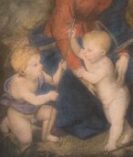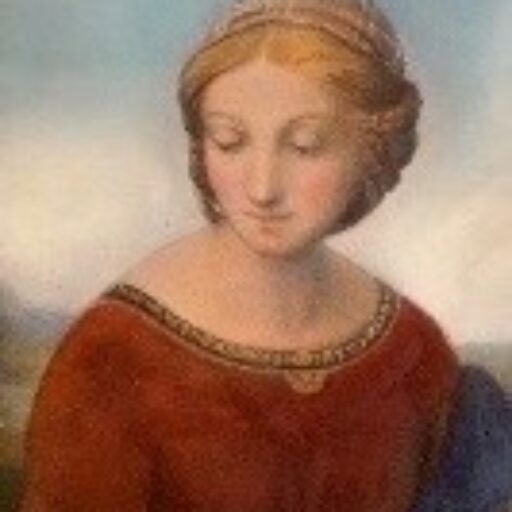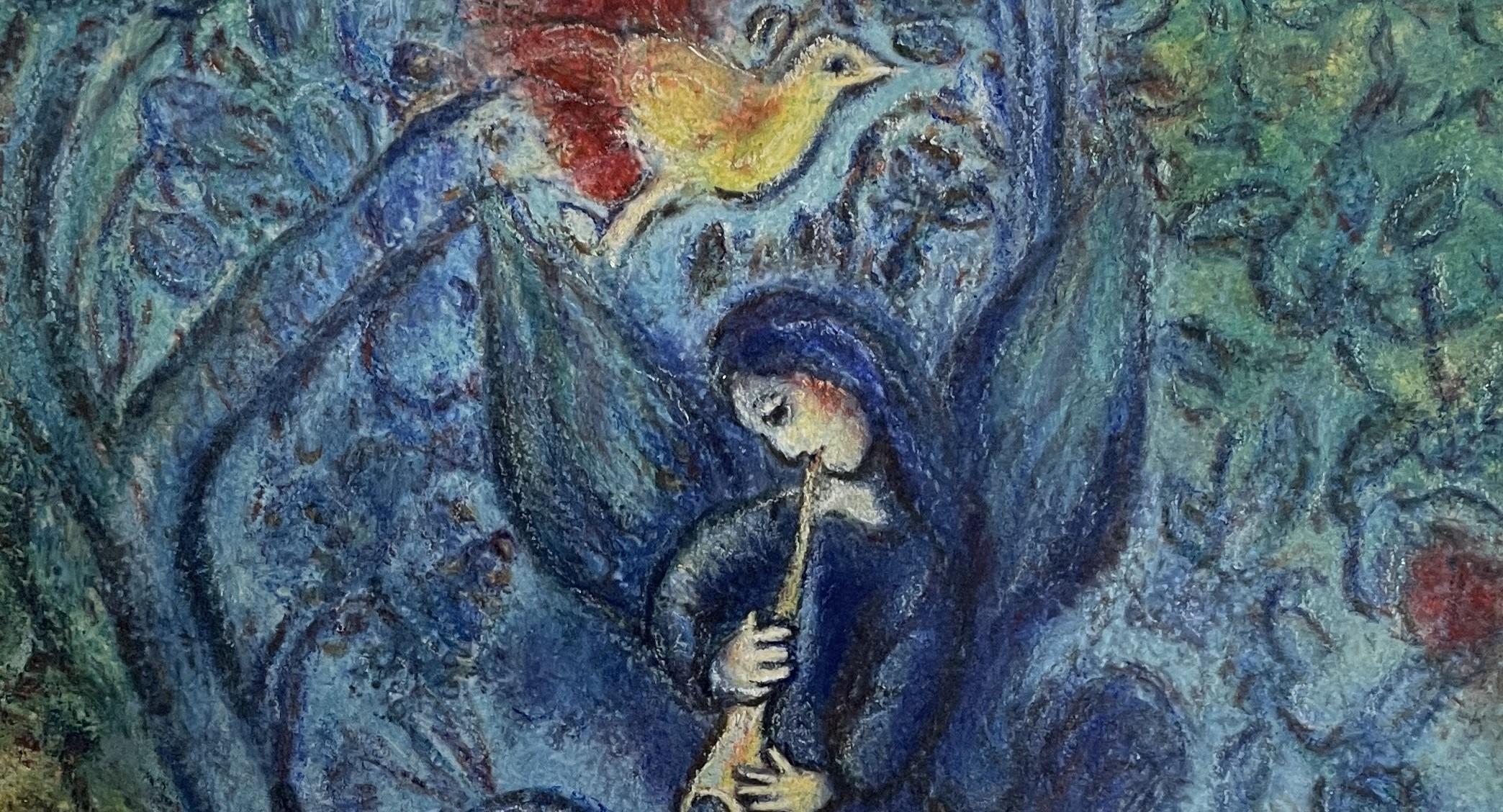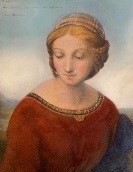日本語-Englishー台灣華語
ラファエロ「草原の聖母」

「草原の聖母」はウィーン美術史美術館にある。ラファエロの数ある聖母の中で、私が最も好きな聖母子だ。私はこの絵を観るためにわざわざウィーンまで行った時のことを思い出す。赤い服に、鮮やかな青いラピスラズリのマントを羽織ったやさしい聖母マリア。彼女にそっと見守られたふっくらとした幼子キリスト。背景の水色の空が爽やかに晴れ渡る。美しい色、美しい仕上がり、美しい構図。ラファエロの聖母子像はとにかく美しい。
かつてハンガリーにある薄塗りで未完成のラファエロの聖母を見たことがあるが、仕上がりが途中の絵であるにもかかわらず、そこには既に確たる美があった。モデルとなった赤ん坊が聖母の実子ではないのか、ちょっぴり老成していてかわいらしさに欠けるのが気にかかるが、聖母は瞼を半分下ろして目を伏せ、慈愛に満ちた優しい眼差しで息子を見つめ、しとやかでやわらかい雰囲気を醸し出している。
私の絵では、幼子は省略し、美しい聖母だけを描くことにする。ラファエロの絵に苦悩は見えない。ルノアールは言っている。「この世は何と苦悩に満ちていることか。だから私は美しい絵しか描かないのだ」と。ラファエロの絵には女性の美点しか見出すことができない。そこにはルノアールと同じ画家の願いが満ちている。ラファエロは友人に出した手紙の中で「美しい女性を描くには、大勢の美しい女性が必要だ」と吐露している。ラファエロは美しい女性を描きながら、自らが理想とする女性像を追い求めていたのかもしれない。
ラファエロはウルビーノで画家の子として生まれている。ピカソと同じく画家になるべくして生まれて来た。若い頃に父親の知り合いであったペルジーノの弟子となる。フィレンツェに出て来てからは、レオナルド・ダ・ヴィンチやミケランジェロの芸術に触れ、大きな成長を遂げる。ラファエロは21歳の頃フィレンツェにやってきたと言われている。ラファエロより31歳年上のレオナルドはこの時52歳、ミケランジェロは30歳であった。絵画技法としてはレオナルドの影響が大きいことが、その頃ラファエロが描いた聖母子を観るとよくわかる。ラファエロは優れた絵画の技法を、たちどころに自分の中に取り入れることに長けていたが、生み出された絵画にはいつもラファエロ独特の甘美なる思いが満ちている。レオナルドが創始した輪郭や色がなめらかに移行して行くスフマート技法は、ラファエロに消化され、美しくも母性的な聖母子像に結実して行く。ラファエロにはレオナルドの描く聖母や女性像にはない、親近感と甘美さがある。聖母子像はキリスト教の重要なモチーフとして昔から数限りなく描かれてきたが、柔らかな色彩で描かれたふくよかな体と、美しい面立ちのラファエロの作品は、それまでの聖母子像とは明らかに異なる。ラファエロは八歳の時に最愛の母を亡くし、その三年後には画家の父を亡くして天蓋孤独となる。幼くして別れた母への追憶と、充分に受けられなかった母親の愛情への願望が、ラファエロの聖母を輝かせる下地になっているのだと思う。 爽やかな容姿と子供の頃から身についた高貴な物腰のラファエロは、宮廷の貴婦人に大変な人気だったらしいが、ラファエロが実際に恋をしていたのはパン屋の娘や人妻であった。
上昇志向の強かったラファエロは画家として法王に寵愛を受ける中で、枢機卿に任命される大きな野心を膨らませていたと言われ、ついぞ結婚することはなかったが、あっけなく三十七歳で人生を閉じる。六十七歳で異国に没した孤高の天才レオナルド、八十九歳まで長寿を全うし作品を作り続けたミケランジェロに比べて短い生涯ではあるが、ラファエロはその美貌のままに人々の記憶にとどまり、美しく崇高な聖母子の姿とともに、五百年の時を越えて生き続けるように運命づけられていたのかもしれない。
The Madonna in the Meadow (The Madonna of Belvedere)
The Madonna in the Meadow” is located in the Kunsthistorisches Museum in Vienna. Among the numerous Madonnas by Raphael, it is my favorite depiction of the Madonna and Child. I remember going all the way to Vienna just to see this painting. The gentle Virgin Mary, draped in a vivid blue mantle made of lapis lazuli over a red dress, tenderly watches over the plump Child Christ. The light blue sky in the background is refreshingly clear. The beautiful colors, the beautiful finish, the beautiful composition-Raphael’s images of the Madonna and Child are simply beautiful.
I have seen an unfinished Raphael Madonna in Hungary, thinly painted, and despite its incomplete state, it already possessed a definite beauty. The fact that the baby, who served as the model, might not be the Madonna’s real child and appears slightly mature, lacking in cuteness, is of concern, but the Madonna, with her eyelids half-lowered and gazing at her son with a tender, loving look, exudes a gentle and soft atmosphere. In my painting, I have decided to omit the child and depict only the beautiful Madonna. Raphael’s paintings do not show suffering. Renoir has said, “This world is so full of suffering. That’s why I only paint beautiful pictures.” Raphael’s paintings reveal nothing but the beauty of women, filled with the same wish of the painter as Renoir. Raphael confessed in a letter to a friend, “To paint a beautiful woman, one needs many beautiful women.” Perhaps Raphael, while painting beautiful women, was in pursuit of his ideal image of a woman.
Raphael was born in Urbino, the son of a painter, destined to become a painter just like Picasso. In his youth, he became a disciple of Perugino, an acquaintance of his father. After moving to Florence, he was greatly influenced by the art of Leonardo da Vinci and Michelangelo, which contributed to his significant development. Raphael is said to have arrived in Florence at the age of 21, when Leonardo, 31 years his senior, was 52, and Michelangelo was 30. The influence of Leonardo is evident in the Madonna and Child paintings Raphael created around that time. Raphael was adept at quickly incorporating excellent painting techniques into his own work, but the paintings he produced were always filled with Raphael’s uniquely sweet sentiments. The sfumato technique initiated by Leonardo, where contours and colors transition smoothly, was assimilated by Raphael, resulting in beautiful and maternal images of the Madonna and Child. Raphael’s Madonna and female figures have a familiarity and sweetness not found in Leonardo’s work. The Madonna and Child motif has been painted countless times as an important motif in Christianity, but Raphael’s works, with their soft colors, plump forms, and beautiful features, are clearly different from earlier depictions of the Madonna and Child. Raphael lost his beloved mother at the age of eight and his painter father three years later, becoming profoundly alone. I believe the memory of his mother, whom he lost at a young age, and his longing for the motherly love he did not fully receive, form the foundation that makes Raphael’s Madonna shine.
Raphael, with his refreshing appearance and noble manners acquired from childhood, was apparently very popular among courtly ladies, but the women Raphael actually loved included a baker’s daughter and a married woman. Ambitious Raphael, favored by the pope as a painter and aspiring to be appointed a cardinal, is said to have never married and ended his life abruptly at the age of thirty-seven. Compared to the solitary genius Leonardo, who died at sixty-seven in a foreign land, and Michelangelo, who lived to eighty-nine and continued to produce works, Raphael’s life was short. However, Raphael remains in people’s memories with his handsome appearance and the beautiful and sublime figures of the Madonna and Child, perhaps destined to live on through the ages for over five hundred years.
拉斐爾・桑齊奧
草原上的聖母(貝爾韋德爾的聖母)
「草原上的聖母」(貝爾韋德爾的聖母)位於維也納美術史博物館。在拉斐爾所有的聖母畫作中,這是我最喜歡的一幅聖母與聖子畫。我記得專程去維也納就是為了看這幅畫。聖母瑪利亞穿著紅色的衣服,披著鮮豔的藍色青金石披風,看起來十分溫柔。她溫柔地守護著圓潤的嬰兒耶穌。背景是清爽的藍天。美麗的色彩、完美的完成度、優美的構圖。拉斐爾的聖母與聖子畫總是如此美麗。我曾經看過在匈牙利的一幅未完成的薄塗拉斐爾聖母畫,儘管畫作未完成,但已經有一種確定的美。畫中的嬰兒並非聖母的真實孩子,稍顯成熟,缺乏可愛之處,這讓人感到些許遺憾。然而,聖母半閉的眼睛和慈愛的目光柔和地注視著她的兒子,散發著溫柔和柔和的氣息。在我的畫作中,我選擇只畫美麗的聖母,省略了嬰兒。拉斐爾的畫作中看不到苦難。雷諾瓦曾說:「這世界充滿了苦難。因此,我只畫美麗的畫。」拉斐爾的畫作中只能看到女性的美。這裡充滿了與雷諾瓦相同的畫家願望。拉斐爾在給朋友的信中提到:「要畫美麗的女性,就需要很多美麗的女性。」拉斐爾在畫美麗女性的同時,也許是在追求他心中理想的女性形象。
拉斐爾出生於烏爾比諾的一個畫家家庭,他生來就注定要成為畫家,就像畢卡索一樣。年輕時,他成為了父親朋友佩魯吉諾的學生。來到佛羅倫斯後,他接觸到了達芬奇和米開朗基羅的藝術,並取得了巨大的進步。拉斐爾在21歲時來到佛羅倫斯,當時比拉斐爾大31歲的達芬奇52歲,米開朗基羅30歲。從那時起拉斐爾畫的聖母子就可以明顯看出達芬奇的影響。拉斐爾很快就能將優秀的繪畫技法融入自己的作品中,但他的畫作總是充滿了拉斐爾獨特的甜美情懷。達芬奇創立的輪廓和顏色平滑過渡的斯弗馬托技法被拉斐爾消化吸收,並在他的聖母子畫中達到了美麗而充滿母性的表現。拉斐爾的聖母和女性像與達芬奇的作品不同,有一種親近感和甜美。聖母子畫作為基督教的重要主題,自古以來被無數次描繪,但拉斐爾以柔和的色彩和豐滿的形體、美麗的面容描繪的作品與以往的聖母子畫顯著不同。拉斐爾八歲時失去了摯愛的母親,三年後又失去了畫家父親,變得孤獨。對早逝母親的追憶和對母愛的渴望成為了拉斐爾聖母光輝的基礎。
拉斐爾以其清新的外表和從小培養的高貴氣質,在宮廷中受到了貴婦人們的極大歡迎,但拉斐爾真正愛慕的似乎是麵包師的女兒和人妻。在受到教皇寵愛並成為畫家的同時,擁有強烈上進心的拉斐爾抱有成為樞機主教的大野心,但終未婚配,不幸在三十七歲時便結束了短暫的一生。與六十七歲在異國逝世的孤獨天才達芬奇,以及活到八十九歲持續創作的米開朗基羅相比,拉斐爾的一生雖短,但他以美貌的形象和美麗崇高的聖母子形象留在人們記憶中,或許是注定要跨越五百年的時光繼續生存下去。


